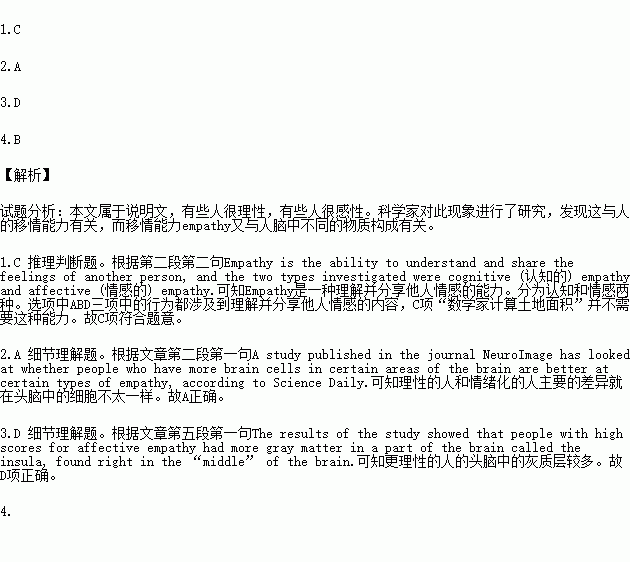题目内容
Do you have an emotional brain or a rational (理性的) one? Researchers at Australia’s Monash University have found actual difference in the brains of people who respond emotionally to others’ feelings compared with those who respond more rationally.
A study published in the journal NeuroImage has looked at whether people who have more brain cells in certain areas of the brain are better at certain types of empathy, according to Science Daily. Empathy is the ability to understand and share the feelings of another person, and the two types investigated were cognitive (认知的) empathy and affective (情感的) empathy.
“Every day people use empathy with, and without, their knowledge to get around in the social world,” said Robert Eres from Monash University’s School of Psychological Sciences. “We use it for communication, to build relationships, and to increase our understanding of others.”
“People who are high on affective empathy are often those who get quite fearful when watching a scary movie, or start crying during a sad scene. Those who have high cognitive empathy are those who are more rational, for example a psychologist helping someone,” explained Eres.
The results of the study showed that people with high scores for affective empathy had more gray matter in a part of the brain called the insula, found right in the “middle” of the brain. Those who scored higher for cognitive empathy had more in a part called the midcingulate cortex—an area above the corpus callosum, which connects the two halves of the brain.
The discovery “raises new questions—like whether people could train themselves to have more empathy, and whether those areas of the brain would become larger if they did, or whether we can lose our ability to empathize if we don’t use it enough”, according to Science Daily.
“In the future we want to investigate further by testing whether training people in empathy-related tasks can lead to changes in these brain areas. We also want to investigate if damage to these brain areas, as a result of a stroke (中风) for example, can lead to empathy problems.” said Eres.
Perhaps in the future we will all be able to empathize more with other people. Maybe you will cry at that sad movie after all!
1.Empathy can be used in the following situations EXCEPT that .
A. when a psychologist is helping a patient with his mental disease
B. when a teacher is comforting a student about his father’s death
C. when a mathematician is calculating the area of a farmland
D. when people are reading a story with a frightening ending
2.What does the research done by Monash University mainly show?
A. Differences in the brains of emotional and rational people.
B. Whether a rational brain works better than an emotional one.
C. What empathy is and how to improve people’s ability to empathize.
D. How to effectively train people to have more empathy cells in their brain.
3.Which of the following statements might Robert Eres disagree with?
A. People use empathy when they are or aren’t aware of it.
B. People tend to use empathy to build relationships or understand others.
C. People with higher affective empathy feel heart-broken when watching sad movies.
D. People who are more rational have been found to have more gray matter in their brains.
4.Which of the following will be one of the focuses of future investigations according to the article?
A. How to train people in empathy-related tasks.
B. Whether people can be trained to be more empathetic.
C. Whether empathy problems can lead to damage to areas of the brain.
D. Why people seem to lose their ability to empathize if they don’t use it enough.

